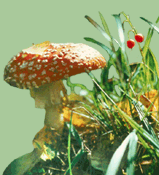The values of forest need to be explained
Hendrik Relve divides the values of forest into layers: the bottom is formed by timber or money, but the top layer is the sweetest, like on cake: the cultural values of forest and the possibility to find mental balance in forest. The central layer is made up of the diverse natural values of the forest. The author gives an overview of changes in forest area in Estonia during the centuries, leading to the first steps of forest management in the end of the 19th century. Until the end of the 20th century, forestry was mostly regarded as a branch of economy responsible for the growth and management of the forest. During the past 20 years, issues like natural and cultural values of forests have been added to the agenda.
Estonian Nature enquires
Aigar Kallas writes about the effects of the reorganization of the State Forest Management Center.
Asko Lõhmus summarizes the state of forest ecology research in Estonia.
How sustainable is the forestry of the world?
Lembit Maamets takes a look farther from the home forest: what is the present condition of the worlds forestry and what could the future bring? Since the term sustainable forestry is difficult to define, the FAOs Global Forest Resources Assessment report explained the term by using seven key elements: 1) the supply of forest resources (the spread and reserve of forest), 2) forest diversity (protection and management of ecosystems), 3) the state and vitality of forest resources, 4) the productiveness of forest, 5) protection function of the forest, 6) the socio-economic element and 7) legislation, policies and social organization. The author explains these elements further and based on different reports, points out some numbers: during 19902005 the territory of worlds forest has decreased by 8.3 billion ha (0.21%) per year. The annual loss of natural forest is 5.9 billion ha (0.52%). At the same time, the area saved for protecting forest biodiversity has increased by 6.4 billion ha/year (1.87%).
The forest habitats of the Nature Directive in Estonia
Anneli Palo describes the Natura 2000 forest habitats and their current status: which habitat types are represented in Estonia? Currently, 11 forest habitat types are differentiated in Estonia. Numerous habitats are difficult to classify. In order to bring some clarity to the issue, the author describes all 11 habitat types and illustrates these with characteristic photographs.
Protected areas: The Tõrasoo nature protection area safeguards forests, mires and alvars
Kalev Tihkan introduces a forested area with tightly alternating alvar and mire habitats, which is of interest to scientists as well as friends of nature. The Tõrasoo protected area is located in North-Estonia, in the heart of the Rapla County and was founded in 2005, occupying over 3000 ha. The protected natural values include semi-natural habitats, forest habitats, and different types of mire habitats as well as protected bird and plant species.
Our Boletuses 11
Vello Liivs new part of the series describing the Boletuses of Estonia.
Interview: The knowledge of the history of forestry helps also todays forestry
Toomas Kukk has interviewed Toivo Meikar, a scientist studying the history of forestry.
The story of nowadays Tarzan
Jaanus Remm tells an exciting story of the development of the top scientist of tree cavity fauna. As a result of his hobby and work, a dissertation on the density, characteristics and occupancy by animals has been written. Generally, the density of tree cavities per hectare is low compared to European forests, most likely because of long-term and intensive forest management. The author describes the different types of cavities and their fauna, as well as the process of tree cavity research, which can be a dangerous work.
Practical tips: How to take a picture of a forest?
Jarek Jõepera looks at reasons why the photos of forest are not always a success and shares advice on getting the best results. It is important to consider the weather, especially light conditions, but also a range of other details. The article is supplemented with expressive examples of good forest photographs by the author.
The hiking trail of Võlsi introduces forest and forest life
Katre Palo took a hike along the Võlsi hiking trail near the town of Võru. The trail is designed to introduce the values of forest and the different management methods that have been in use during centuries.
The tree of the year: Dont eat the berries of the Yew tree!
Urmas Kokassaar warns against the hazardous seeds that are hidden in the eye-catching red berries of the Yew tree. The berries contain taxine poisonous alkaloids that may be extracted from the leaves and seeds of the Yew tree. Taxine can kill people as well as domestic animals, especialy horses, pigs and cows.
The need to protect forest: a case study of the Bayer Forest
Rainer Kuuba recalls the outbreak of the deathwatch beetle in the spruce forests of the Bayer Forest National Park and suggests learning some lessons from it. In Bayer, trees on 4000 ha dried due to the outbreak. The local officials decided to have nature heal the wounds. It turned out that nature can take of itself, since the biodiversity in the forest has been increasing again. The author points out that species-rich old grooves should be protected within managed forests as well.
|


![[IN ENGLISH]](images/gb.gif)





